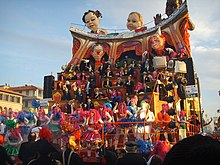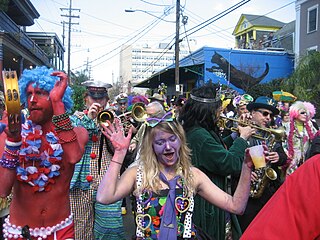
Mardi Gras is the final day of Carnival or Shrovetide before Ash Wednesday. Mardi Gras is French for "Fat Tuesday", reflecting the practice of the last night of consuming rich, fatty foods in preparation for the fasting season of Lent.

Carnival or Shrovetide is a Christian festive season that occurs before Lent, consisting of Quinquagesima or Shrove Sunday, Shrove Monday, and Shrove Tuesday or Mardi Gras.

A masquerade ball is a special kind of formal ball which many participants attend in costume wearing masks. Less formal "costume parties" may be a descendant of this tradition. A masquerade ball usually encompasses music and dancing. These nighttime events are used for entertainment and celebrations.

The holiday of Mardi Gras is celebrated in southern Louisiana, including the city of New Orleans. Celebrations are concentrated for about two weeks before and through Shrove Tuesday, the day before Ash Wednesday. Mardi Gras is French for Fat Tuesday, the season is known as Carnival and begins on 12th Night, January 6th, and extends until midnight before Ash Wednesday. Club, or Krewe, balls start soon after, though most are extremely private, with their Kings and Queens coming from wealthy old families and their courts consisting of the season's debutantes. Most of the high society Krewes do not stage parades. As Fat Tuesday gets nearer, the parades start in earnest. Usually there is one major parade each day ; many days have several large parades. The largest and most elaborate parades take place the last five days of the Mardi Gras season. In the final week, many events occur throughout New Orleans and surrounding communities, including parades and balls.
A patronal feast or patronal festival is a yearly celebration dedicated – in countries influenced by Christianity – to the 'heavenly advocate' or 'patron' of the location holding the festival, who is a saint or virgin. The day of this celebration is called patronal feast day, patronal day or patron day of said location.

Viareggio is a city and comune in northern Tuscany, Italy, on the coast of the Tyrrhenian Sea. With a population of over 62,000, it is the second largest city in the province of Lucca, after Lucca.
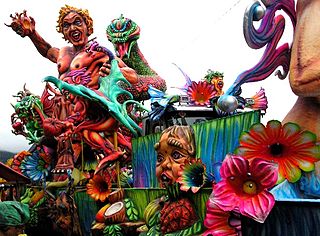
Blacks and Whites' Carnival, is a Carnival public festival and parade in southern Colombia established in 1546. Although its geographical location belongs to the city of Pasto, it has been adopted by other municipalities in Nariño and southwestern Colombia. It is celebrated every year in 2–7 January and attracts a considerable number of Colombian and foreign tourists.

The Carnival of Venice is an annual festival held in Venice, Italy, famous throughout the world for its elaborate costumes and masks. The Carnival ends on Shrove Tuesday, which is the day before the start of Lent on Ash Wednesday.
Putignano is an Italian town of 26,644 inhabitants located in the Murgia of the Metropolitan City of Bari, in Apulia, southern Italy. It is known for its ancient Carnival, for textile manufacturing companies and for karst caves.

Mardi Gras is the annual Carnival celebration in Mobile, Alabama. It is the oldest official Carnival celebration in the United States, started by Frenchman Nicholas Langlois in 1703 when Mobile was the capital of Louisiana. Although today New Orleans and South Louisiana celebrations are much more widely known for all the current traditions such as masked balls, parades, floats and throws were first created there. From Mobile being the first capital of French Louisiana (1702), the festival began as a French Catholic tradition. Mardi Gras has now evolved into a mainstream multi-week celebration across the spectrum of cultures, becoming school holidays for the final Monday and Tuesday, regardless of religious affiliation.
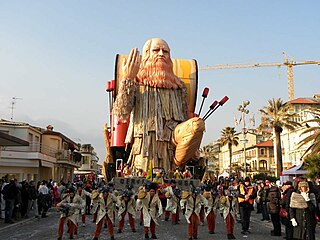
The Carnival of Viareggio is a Carnival event annually held in the Tuscan city of Viareggio, in Italy. It is considered amongst the most renowned Carnival celebrations in both Italy and Europe.

A variety of customs and traditions are associated with Carnival celebrations in the German-speaking countries of Germany, Switzerland and Austria. They can vary considerably from country to country, but also from one small region to another. This is reflected in the various names given to these festivities occurring before Lent.
Carnevale is an Italian word derived from the Latin expressions carnis and "levare". So "carnevale" means literally "remove meat". It refers to the Tuesday before Ash Wednesday, the beginning of Lent, the traditional Christian period of 40 days before Easter, commemorating the 40 days Jesus fasted in the desert, which was a period of abstaining from meat and other pleasures of the flesh. So it was the day to get those last enjoyments in. "Mardi gras" refers to the same day. Also known as "Shrove Tuesday". In Italy this holiday is celebrated with parades where children dress up in costumes. The most famous parade and exhibition of elaborate costumes is in Venice. Traditional pastries of fried dough covered in powdered sugar are also wildly available in local bread shops.

The Carnival in the Dominican Republic is a Dominican celebration that takes place throughout February, and sometimes during Holy Week in March. Dominican Carnival is celebrated in most cities and towns in the main streets. The carnival season in the Dominican Republic kicks off with a carnival gala held indoors in Santiago de los Caballeros, as opposed to every other carnival event held outdoors throughout the month of February. Among its main characteristics are its flashy costumes and loud music. The one held in La Vega, which is one of the biggest in the country, and the national parade in Santo Domingo, were the first Carnivals held in the Americas.
Haitian Carnival is a celebration held over several weeks each year leading up to Mardi Gras. Haitian Defile Kanaval is the Haitian Creole name of the main annual Mardi Gras carnival held in Port-au-Prince, Haiti.

Traditions of Italy are sets of traditions, beliefs, values, and customs that belongs within the culture of Italian people. These traditions have influenced life in Italy for centuries, and are still practiced in modern times. Italian traditions are directly connected to Italy's ancestors, which says even more about Italian history.
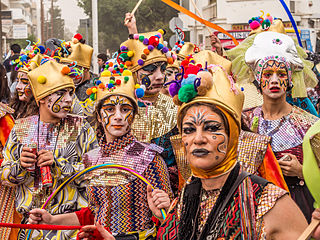
The Limassol Carnival is an annual European carnival event held in Limassol, Cyprus. The main parade is held 12 days before the start of Lent, on the Sunday before Ash Monday, 50 days before Orthodox Easter. The festival is a colourful 10-day event of people eating, singing, satire, games, wearing costumes, and attending parties. The festival culminates with a large parade, which includes an array of floats traversing the city.

Slavic carnivals are known under different names in various Slavic countries: Bulgarian: Сирни заговезни, Прошка, Поклади, romanized: Sirni zagovezni, Proshka, Pokladi; Macedonian: Прочка, romanized: Pročka; Russian: Масленица, Мясопуст, romanized: Maslenitsa, Myasopust; Polish: Ostatki, Mięsopust, Zapusty; Czech: Masopust, Šibřinky, Ostatky; Slovak: Fašiangy; Slovene: Mesopȗst, Pust, Pustni teden, Fašnk; Serbian: Покладе, Проћка / Poklade, Proćka; Croatian: Pust, Poklade, Mesopust, Fašnik. They are traditional Slavic festivals related to the period of carnival.

The Carnival of Satriano, held in Satriano di Lucania, Italy every February, is one of the country's many carnivals. Held on the Friday, Saturday and Sunday before Fat Tuesday, it has been conducted for centuries. The event is among the most important carnival traditions of the region and of Italy and it is unique in that participants wear costumes, or masks, of bears, hermits, or lent.

Carnival in Goa, also called "Carnaval", "Intruz", "Entrado", or (colloquially) "Viva Carnival" refers to the festival of carnival, in the Indian state of Goa. Though significantly smaller than the well-known Rio Carnival or the Portuguese Carnival of Madeira, the Goa Carnival is the largest in India and one of the few traditional celebrations of the Western Christian holiday in Asia. The current version of the Goa Carnival was modelled after the Rio Carnival by a local musician named Timoteo Fernandes and imposed in 1965 to attract tourists. It has since turned into a major tourist attraction for the small state.

